#doreen massey
Photo
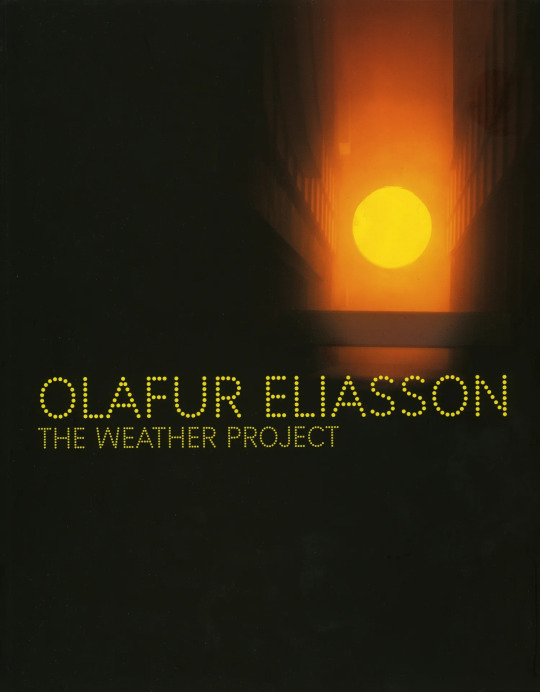
Olafur Eliasson: The Weather Project, Edited by Susan May, Texts by Olafur Eliasson, Jane Burton, Helen Charman, Brian Gray, Sophie Harrowes, Jacques Herzog, Bruno Latour, Doreen Massey, Susan May, Israel Rosenfield, Nicholas Serota, and Dominic Willsdon, Design by Chris Rehberger, Tate Publishing, London 2003 [Exhibition: Turbine Hall, Tate Modern, London, October 16, 2003 – March 21, 2004]
(on the way of Art Books & Ephemera)
#graphic design#art#installation#catalogue#catalog#cover#olafur eliasson#studio olafur eliasson#susan may#jane burton#helen charman#brian gray#sophie harrowes#jacques herzog#bruno latour#doreen massey#israel rosenfield#nicholas serota#dominic willsdon#chris rehberger#tate#tate modern#tate publishing#2000s
28 notes
·
View notes
Text
DOREEN MASSEY MISS GIRL U NEED UR PUSSY ATE UR A GENIUS ALL I NEED ACADEMICALLY IS YOU ILYSM <333
0 notes
Text
look i am not saying one shouldn't be concerned about their safety like i will admit the fear of delhi as a female presenting person haunts me no matter how much i also love what the city offers, but as a sociology student you can't expect me to not want to crack into what is possibly behind the relationship between fear disgust and space like i will talk your ear off about public places and heterogeneity i did that one time and the whole class hated me for it
#vidhik.txt#i am having thoughts again#i want to read that paper again#and maybe some more of doreen massey
1 note
·
View note
Text
youtube
It would be an understatement to say that the Star Wars sequel series was not received well. If you look at the many videos on the subject, they criticise everything from the story to the score. There is much to criticise, as many have, but not many have talked about how the Star Wars space changed after they released the sequels and what it ultimately means for the Star Wars fandom. The topic of Space and psycho-geography is very interesting when applied to fictional spaces. Whilst you cannot go to the galaxy far far away, it acts as an escape for anyone who watches it. This gives the ‘place’ an identity, one which you can go to. This brings me onto the subject of this video: Spatiality and Doreen Massey.
#film#video essay#youtube#star wars#star wars sequels#star wars essay#star wars prequel#star wars rey#Youtube
3 notes
·
View notes
Text
Territorio en las alturas
Según Gerardo Damonte.
¿Qué es un territorio?
El territorio es fruto de un proceso social e histórico que cambia a partir de los años, por lo que el territorio es un espacio social construido.
¿Cómo se construye un espacio social?
El espacio social es todo lugar físico donde nosotros vivimos, los lugares donde crecimos y jugamos de pequeños, lugares donde interactuamos con el espacio y con los que conviven en ese espacio. Los objetos que llenan este espacio son símbolos a los que les damos un significado distinto, como las bancas donde tenemos recuerdos, un árbol y una plaza; que le dan sentido a este espacio fisico, asi que lo primero que identificamos son las vivencias, luego los recuerdos, como las memorias que tiene nuestros padres de los barrios, memorias anteriores a las nuestras y por último el conocimiento histórico del lugar que nos pueden entregar los libros.
En las alturas de mi ciudad natal, Viña del Mar, se encuentran paisajes que han sido una fuente constante de inspiración y reflexión para mí. En esta investigación personal, me dispongo a explorar la belleza y el significado de mi territorio, desde los miradores de la ciudad. Más allá de la simple representación visual, mi objetivo es profundizar en las dimensiones emocionales y psicológicas de estos espacios sociales, así como en su conexión con mi propio sentido de pertenencia y arraigo con el territorio.
Mi concepción del territorio y su significado emocional se enmarca en las ideas de la geógrafa Doreen Massey, quien habla del espacio social no solo como un simple contenedor estático, sino como un lugar lleno de significado y relaciones socioculturales que fluctúa constantemente. En mi caso, la falta de sentido de pertenencia me lleva a buscar refugio y conexión en los espacios naturales, apartados y tranquilos de los miradores de Viña del Mar.
Mi investigación se materializa a través de la creación de pinturas en grandes formatos, que representan los atardeceres de otoño vistos desde los miradores que visitaba con frecuencia en mi diaria necesidad de estar lejos de casa. La belleza y la serenidad del paisaje se convirtieron en protagonistas de mis largas horas de soledad, creando mi conexión emocional y psicológica con el territorio. La vista aérea de la ciudad desde la altura de los cerros añade pistas del lugar en el que me encuentro, enriqueciendo el significado y el contexto de mis creaciones, que nos invitan a reflexionar sobre la relación entre el individuo y el territorio, así como sobre la importancia de establecer conexiones emocionales y psicológicas con el entorno. Los atardeceres de otoño se convierten en metáforas de mi búsqueda de pertenencia y arraigo en un lugar que ahora siento un poco más propio.
1 note
·
View note
Text









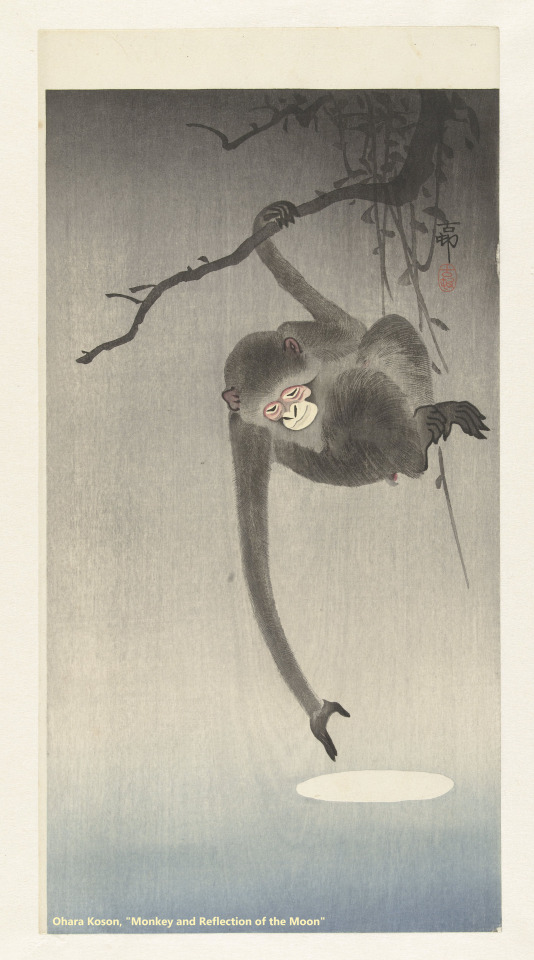







on preservation
The Theory and Craft of Digital Preservation (Trevor Owen) || "Death of an Era": Last Hours of Hawthorne's House, Rock Ferry, Birkenhead, Wirral (Geoffrey Moore) || The Magic of Light and Shadow (Rashad Alakbarov) || "The Lost Breath of Trees" (Colleen K. McElroy) || Making Surimono for the New Year (Katsushika Hokusai) || "The Opposite of Abandonment" (Alexis Aceves Garcia) || "Wrestling With Shape Shifters": Perspectives on Preserving Memory in the Digital Age (Kenneth Thibodeau) || Butterflies (Ernst Fröhlich) || Monkey and Reflection of the Moon (Ohara Koson) || What Happens When We Stop Remembering? (Heidi Lasher) || Willamette River Channels (Dan Coe) || drawings by a boy named Onfin (weird medieval guys) || Letter from 3-year-old August von Goethe to his father J.W. v on Goethe (GSA 28/2 Bl. 155) || for space (Doreen Massey)
#web weaving#digital preservation#history#memory#yes this came out of readings for my course. no one perceive me#even worse the first draft of this was like. twice as long lol#what else can you do when you're feeling shrimp emotions about collective memory#my art#pretty words#xuserann
48 notes
·
View notes
Text

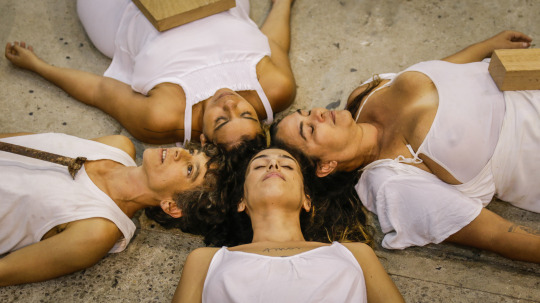
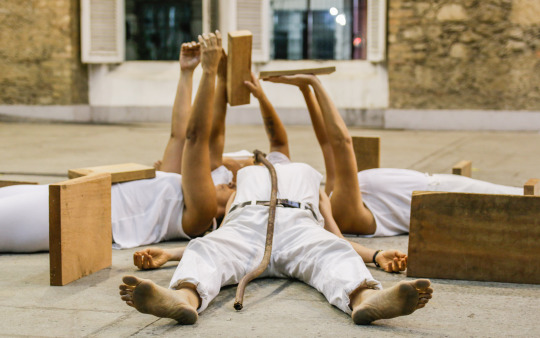
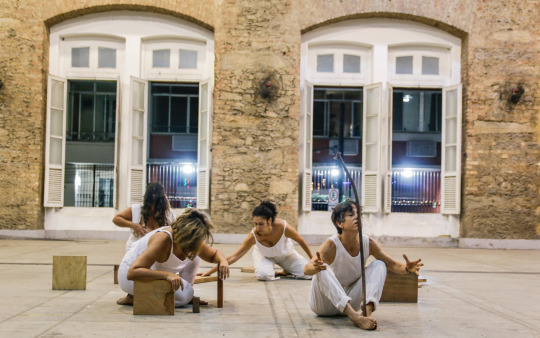
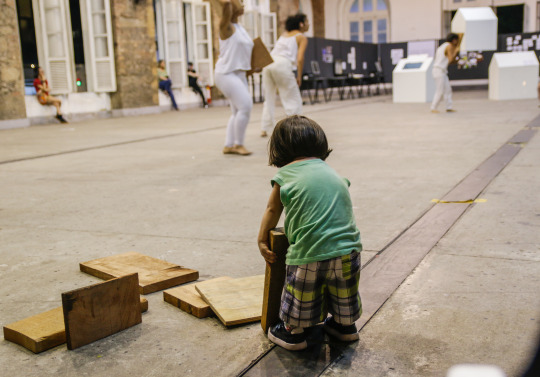


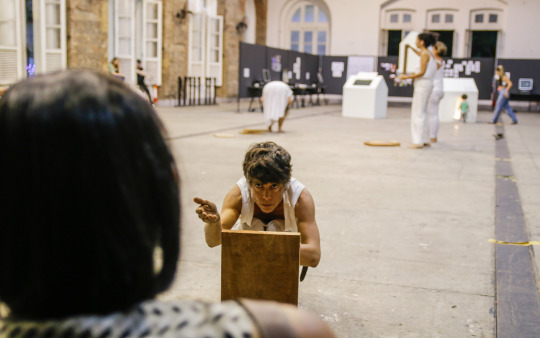

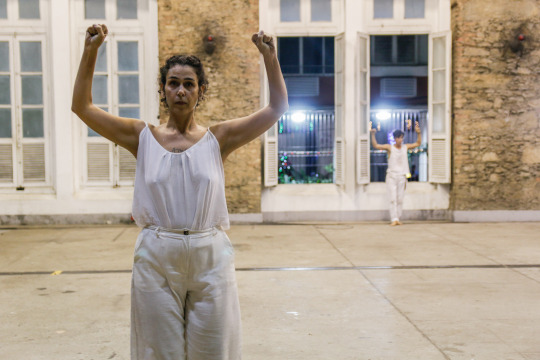

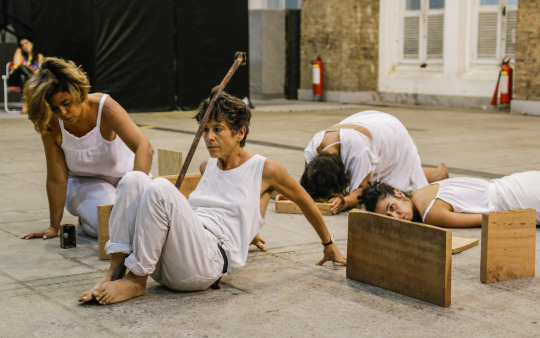
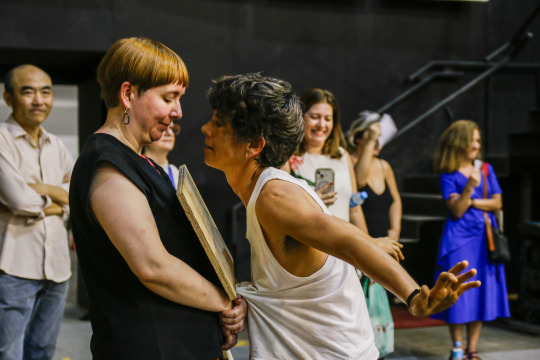

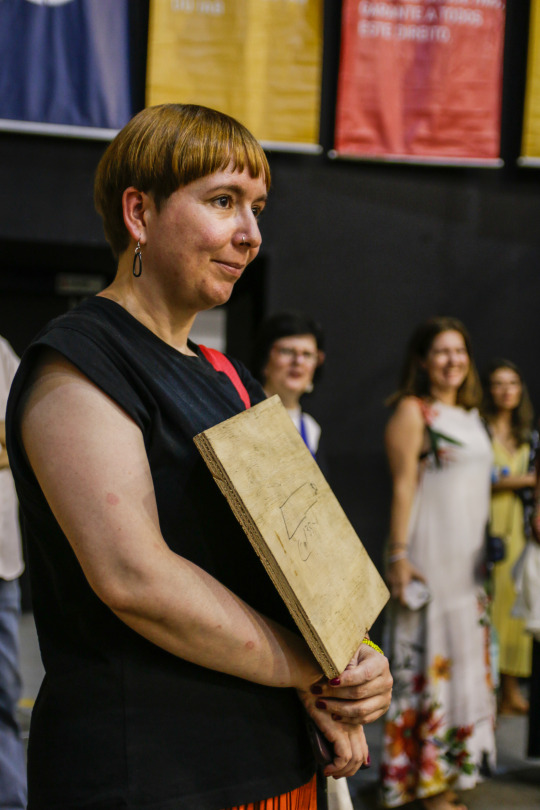



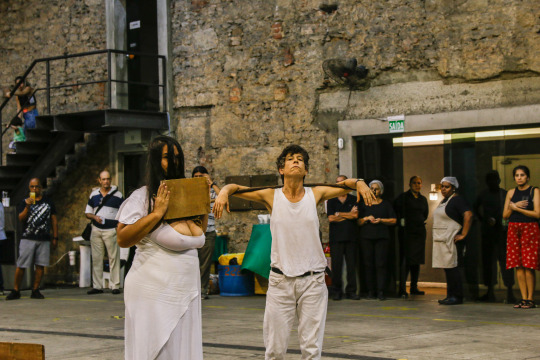
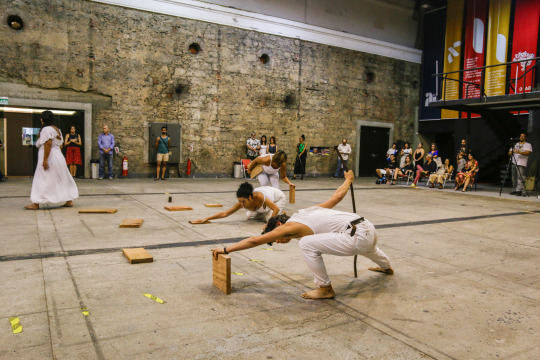
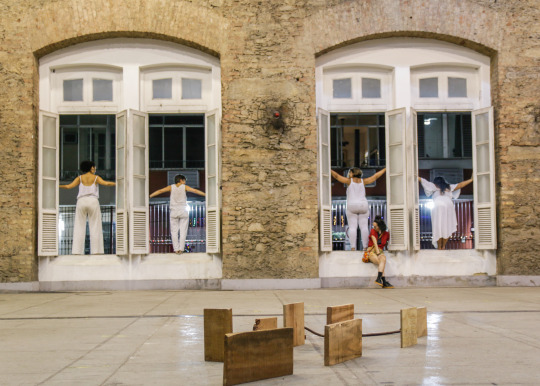
Photo: Gabrielle Souza / Instituto Cervantes RJ.
A CIDADE QUE MORA EM MIM
LA CIUDAD QUE VIVE EN MÍ
Anotações corporais para uma filosofia da espacialidade
Performance coletiva site specific (25min)
Direção de Laura Corcuera
Laura Corcuera + Marta Moura + Muca Velasco + Dani Bargas
Colaboração transfeminista LA PEREREKA
6 dezembro de 2023, entre 19h-20h, Instituto de Arquitetos do Brasil (IAB), Rio de Janeiro.
Qual a responsabilidade política, social e estética da arquitetura na perpetuação da desigualdade em uma cidade, tanto historicamente quanto na atualidade?
Existe uma parte do imaginário da cidade do Rio de Janeiro compartilhada pelas mulheres que vivem lá, tanto nativas quanto adotadas? Em caso afirmativo, qual é essa parte?
Se a identidade dessa cidade só é compreensível a partir de sua história colonial, racista, escravagista, machista e patriarcal, e também a partir de suas múltiplas histórias de resistência e criatividade coletivas, que memórias e arquivos corporais podemos canalizar aqui, agora, juntas, quatro artistas que moram no Rio?
Quatro células interconectadas, a partir de suas cargas experienciais e práticas feministas, realizam uma performance espacial no Instituto de Arquitetxs do Brasil no Rio de Janeiro. Durante 25 minutos, o quarteto cria uma partitura de ações que ativa o espaço (e vice-versa) para refletir, a partir do corpo, sobre as geometrias desiguais que constroem a cidade globalizada que habitamos e à qual sobrevivemos (ou não) hoje.
Em sua extensa carreira de pesquisadora e em sintonia com os ensinamentos de Milton Santos, a geógrafa Doreen Massey enfatizou a necessidade de uma profunda reflexão sobre o espaço como um instrumento indispensável de poder e enfatizou seu caráter social para provocar as mudanças necessárias em nosso tempo. A arquiteta Lina BoBardi fez algo semelhante.
Porque o espaço pode ser entendido como um organismo vivo, construído por uma multiplicidade de interrelações globais e locais que sustentam a vida ou a aniquilam. Essa performance é um convite para pensar em entender a cidade a partir do lugar que vive em você.
"A cidade que mora em mim" é uma ação site-specific dirigida pela artista, pesquisadora e jornalista espanhola Laura Corcuera, criada ad hoc junto com Marta Moura, Dani Bargas e Muca Vellasco, artistas feministas residentes no Rio de Janeiro e colaboradoras da Colab La Perereka para a exposição "Arquitetura e feminismos: Sem começo nem fim" do Instituto Cervantes. Essa ação artística tem como objetivo contribuir para a ampliação das formas poéticas de ativismo político e social.
----------------------------------------------------------
Laura Corcuera, artista peformer, escritora e jornalista espanhola. Diretora da Colab La Perereka e da Banda de Performance (Rio de Janeiro), cofundadora do jornal EL SALTO (Espanha), autora da Ruta de la Performance (Pikara Magazine). Sua experiência de mundo e seu corpo são o primeiro arquivo de Corcuera para uma investigação sobre práticas artísticas, tecnopolíticas e comunicativas e sua capacidade coletiva de transformação social. @laucorcuera
Marta Moura, artista visual, performer, ativista da pauta feminista, antirracista, anticapacitista e antilesbotransfóbica. Integra a Operativa Nacional do Levante Feminista Contra o Feminicídio Lesbocídio e Transfeminicído, a Articulação de Mulheres Brasileiras, a Rede de protecionistas Projetemos e as Inclusivass Feminista, e também o movimento de mulheres com deficiência do Rio Grande do Sul. @moura_marta_
Muca Vellasco, multiartista e produtora cultural, mãe solo de 5 filhos, mulher LGBTQIA, dirigiu e produziu o curta "Gente que brilha" (2016) e o documentário do festival Manas Raras. Fundadora e Produtora Executiva do Coletivo Coisa Rara e do Sarau Portas Abertas Teresópolis. Produtora Executiva das Mulheres da Pequena África e de Jonatas Belgrande. @mucathebest
Danielle Bargas, artista performer, atriz, educadora popular, articuladora comunitaria, em breve sanitarista. Colaboradora do Institute for the Developmente of Humans Art – IDHA (NYC – EUA). Componente da Rede Latino Americana de Arte e Saúde Mental. Colaboradora do Bloco carnavalesco Doido é Tu! de Fortaleza (CE) Colaboradora do coletivo carnavalesco Tá Pirando, Pirado, Pirou! (RJ). @pedagogiadoscuidados
CRÓNICA A OCHO MANOS
MUCA VELLASCO
O espaço de IAB estava receptivo e senti que a potência já estava conosco ao me demarcar em minha posição ao início da performance. Percorri, em diagonal, rumo ao ponto de enraizamento onde sentei no círculo preto e logo as cabeças e as energias de minhas companheiras se acopladas a minha e então me concentrei profundamente ao centro da terra de onde senti a limpeza energética e a sua renovação. De olhos fechados, sentia um sol brilhando sobre nós, proporcionando uma confiança que expandia meu plexo solar. Aquietei e pedi permissão ao espaço e ao meu corpo para que ele comandante dali em diante, quando senti de me movimentar os braços na vertical segurando minha torre de madeira. Notei que as xonoanheiras estavam em movimentos sincronicos. Senti a criança interior pedir para explorar com toda a planta dos meus pés o espaço e assim fui explorando enquanto alguns corpos humanos e não humanos interagiam comigo. Em determinado momento, uma energia potente e agressiva pedia licença para ser liberada e precisei chutar e derrubar todos os monumentos que eu olhava. Uma moça se conectou com isso e adentrou à performance e jogou uma das placas de madeira no chao .Entreguei uma cidade a um espectador que olhou-me e interagiu timidamente embora o chamei para vir ao centro, ele preferiu ficar no lugar.
O fio de meu vestido se soltou e eu medianamente percebi que ele também estava performando , quando instintivamente o trouxe ,esticado, à altura dos olhos e assim, brinquei de buscar/esconder outros olhares. Algumas pessoas participaram dessa interação e entraram na performance. Uma criança participou da performance tanto quanto nós. Ao perceber que nosso tempo acabava movimentos de todas paras as janelas e então lá estávamos olhando a cidade pelas janelas e olhando as pessoas que nos olhavam.
DANI BARGAS
Blocos de madeira e tubo de ferro dispostos no centro do espaço em linhas retas, com perspectivas diferentes.
1 a 1 as corpas de 4 mulheres, que estão nos extremos de um espaço quadrado, se deitam no chão, entre os objetos.
Cabeças conectadas.
Respirando. Juntas visualizam um fio que sai da buceta, e cresce e engorda quando se conecta ao centro da terra. Se nutrindo e se limpando ao mesmo tempo. Enraizamento.
Cada uma ao seu tempo, começam a nascer movimentos nas corpas dessas mulheres.
As cabeças se desconectam fisicamente para se conectarem também ás suas corpas, aos objetos, ao espaço e às pessoas. Ativar.
Experimentam fluxos e relações. Play.
Brincam. Divertem-se.
Conexão.
Mover dentro e fora.
Relação.
Espaço.
Corpo.
25 minutos.
As mulheres seguem para grandes janelas que habitam o espaço da cidade que essas mulheres habitam. Sobem pelas janelas, observam, não pulam. Observam o público que as observa.
Relação.
O espaço está imenso.
MARTA MOURA
1. Eu tenho o entendimento que não temos um corpo e sim, que "somos nosso corpo". Somos tudo que pensamos, comemos, sentimos, falamos, ouvimos..."o corpo é o território do sujeito", mas
hoje, enquanto acontecia a palestra de abertura, fiquei a maior parte do tempo no espaço onde iríamos performar "a cidade que mora em mim"...e comecei um exercício de visualizar "meu corpo cidade". Foi
divertido e muito interessante imaginar que se eu estivesse na água onde seria "meu litoral", gostei de imaginar as "minhas montanhas", como se meu corpo se transformasse em um mapa, imaginei pessoas,
famílias, histórias que me habitavam...estabeleci uma conexão com "nossa cidade", criada com os objetos, o espaço, meu corpo-pele-cidade e minha cidade interna, de mulher carioca.
2. Iniciamos a performance, e no enraizamento, percebi que estava com "frio na barriga" e meu objeto ajudou a perceber e sentir minha respiração, no aqui e agora. Entrei no fluxo do CsO - Corpo Sem
Órgãos - de Deleuze, onde estava inteira e plena, durante o tempo todo de performance, a biologia e a ideia de funcionalidade, não existia mais. Era eu, repleta de vida e desejo, por isso, tenho dificuldade de descrever cenas e/ou desmembrar em momentos. Me diverti, olhei minhas companheiras, brinquei com nossos objetos, experimentei livremente...fui bem egoísta: não estabeleci relação com o público, mas fiquei bem assim. Amanhã tento escrever mais a respeito. Estou feliz e grata por esse encontro e pela oportunidade desse momento, que ainda reverbera em mim.
LAURA CORCUERA
La nave del Instituto de Arquitectos de Brasil (IAB) en Río de Janeiro se calienta cuando colocamos las maderas y el hierro en el suelo de cemento pulido. El público se queda acuerpado en los laterales de la nave y nosotras empezamos nuestra acción con la geometría del cuadrado. Cada una desde una esquina de un cuadrado imaginario caminamos hasta el centro del espacio, donde se encuentra la composición maderas y hierro que hemos creado previamente. Una estrella de cuerpos tumbados boca arriba sostienen otros cuerpos objeto en el vientre. Madera, hierro y carne respiran a la vez. En el aquí y en el ahora del 6 de diciembre de 2023, en aquella bochornosa tarde carioca, despierta una energía colectiva que va a homenajear, señalar y denunciar la ciudad al mismo tiempo. Empiezo con micro-movimientos desde el pecho. Tengo un hierro sobre mi cuerpo. Es un hierro que he roto antes de la performance, un hierro que encontré en la calle, paseé por el Hospital psiquiátrico Nise da Silveira y llevé al IAB junto a las maderas recicladas de la calle Frei Caneca donde se ubica la colab La Perereka. El hierro nos guía. La madera nos guía. Movimientos espasmódicos, ojos semiabiertos, el cuerpo saca los miedos y las violencias que la ciudad me inocula y contra las que lucho a diario. El objeto se hace sujeto y mi cuerpo simplemente se deja llevar. Salto. Corro. Siento cerca a mis compañeras, pero me siento sola. Entonces una mano llega a mi espalda. Lentitud. Creamos imágenes en quietud. Son imágenes que hacemos las cuatro, con la participación de algunas personas que entran en el juego de sostener una madera, un hierro, una posición. Las trabajadoras y trabajadores del catering que habrá después de nuestra performance son invitadas a sostener una madera. Un trabajador se queda hasta el final de la acción sosteniendo una madera como una bandeja. Mantener una posición es a veces doloroso y a veces cómico. Un niño de dos años nos imita. Reúne maderas y las deja caer en el suelo. Pide aplausos tras el derrumbamiento. Y vuelve a empezar. Como nosotras. Maderas edificios cuerpos de la ciudad caen y vuelven a erigirse con otra dirección, con otra intención. Las maderas siguen sus propias trayectorias. El hierro también. De la rectitud a la diagonal. De la dureza a la maleabilidad. Vamos vestidas de blanco, en medio del gris y del marrón. Alineamos las maderas y el hierro, creando otra escultura que desplaza la imagen inicial de las maderas. Maderas edificios dominó, como el ineuietante diseño que hizo Carmen Portinho en 1936 para la ciudad de Brasilia. Nosotras recorremos ahora los huecos de esas maderas, los entretiempos de una ciudad sentida y palpitada en sus bellezas y horrores. De la complicidad con otras mujeres nacen las lágrimas de un recuerdo. Algo que pasó, que pasa, que pasará. No somos cuatro, somos 4.000 millones. Me acerco con una madera en la boca hasta el público. Una mujer agarra con su boca el otro lado de la madera. Otra mujer se resiste a sostener la madera con las manos, pero transformo su timidez en juego, complicidad y negociación. Las amplias ventanas del IAB, abiertas para la acción, se convierten en nuestra línea de fuga, un horizonte compartido que reclama el derecho a la ciudad. Al terminar la performance, cada una de nosotras en una ventana, otra mujer vestida de rojo se cuela en la foto. Blanco y rojo se unen en el incomprensible significado de las casualidades. Muca, Dani, Marta y yo hemos creado un vínculo nuevo y poderoso basado en algo que puede llamarse “afecto creativo”. Una herramienta de resistencia al capitalismo que nos ayuda a levantarnos cada mañana y seguir creando juntas otra idea de ciudad. Tras la acción recibimos felicitaciones, pero nadie habla lo que ha sentido al ver nuestras partituras corporales durante 25 minutos y 16 segundos. Quizás aquí, en esta ciudad global, lo más importante sea aquello que no se dice.
0 notes
Text
on Social geographies of race: Connecting race and space
This article focuses on analyzing race from a spatial perspective, which was still an emergent practice at the time of publication (2011). Neely and Samura offer a framework for theorizing racial space, including four characteristics of space: contested, fluid and historical, and interactional and relationship, and defined by inequality and difference. This article begins with three research questions:
1. What about race can we understand better through the lens of space
2. "How is racial inequality organized spatially?"
3. "How do spaces come to be known and used in racialized terms?"
Their aim with this article is to tie together their own explorations of race and space across several disciplines into a method that is "...clearer and more analytically useful." (p. 1934). To accomplish this, first they draw on a targeted literature review of spatial studies. Next, they provide characteristics supporting a theory of racial space: contested, fluid and historical, and interactional and relationship, and defined by inequality and difference. Of this, Neely and Samura note four key issues that contribute to theory of racial space: segregation, (dis)placement, spatial contestations, and place attachments. The authors are focused on collapsing the academic divide of race and space and defining how the two are intrinsically linked.
Neely and Samura situate contemporary critical spatial studies beginning in the 1960s due to several social and cultural revolutions and the emergence of identity politics. In their analysis, three key authors are noted for laying the groundwork for the discipline and their theory of racial space.
Yi-Fu Tuan (1977) - First geographer to study human engagement with space and place.
Henri LeFebvre (1991) - Using marxist theory to a framework for “studying spatial processes that makes necessary linkages between culture and political economy” with spatiality taking center stage. LeFebvre explains the inherent power of providing/denying space to limit economic and/or political power.
Doreen Massey (1993)- Warns against the “de-politicization or neutralization” of space, stating that space is “‘a complex web of relations of domination and subordination, of solidarity and cooperation’.
The key characteristics of space, as defined by Neeley and Samura:
Contested - The terms “space” and “spatial” are contested terms; they’re political and their definitions change with who’s defining them. To explain further, Neeley and Samura lean on Low and Lawrence-Zuniga explanation of contested spaces: “‘geographic locations where conflicts in the form of opposition, confrontation, subversion, and/or resistance engage actors whose social positions are defined by differential control of resources and access to power”. (p.1938). Both the contested nature of space and its definitions reminds me of my own struggle with articulating the differences between justice and equity. There are a multitude of similar, yet subtle differences in definitions depending on the experiences of the actor who is using it.
Fluid and historical - The “constentations” cause the definitions or meanings to change over time, thus “Space has come to be seen not as a fixed cultural thing, but rather as a multi-vocal, fluid process.”
Relational and historical - Space is also defined by “relational and interactional processes” in that space “also involves social actors (individuals, groups, institutions) who create, disrupt and recreate spatial meanings through interaction with one another.”
Difference and inequality - “the political struggles over space play out through structures of difference and inequality that define and organize spaces according to dominant interests” or, as Neely and Samura state, “The meanings and uses of space have much to do with defining who does and who does not have the power to define and control space.” which is a crucial point in the overlap in racial and spatial studies.
Connections to my research interests:
As Neely and Samura start to narrow in on their own theory of racial space, they introduce Caroline Knowles whose concept of the active archive provides linkages between “sociality and the history of enmeshed in space.” So, as I understand it (hopefully I am understanding this correctly) space contains multiple histories and when overlain with race, we have the construction of how the construction of race collides with the history of that construction the space those (of that race) physically and culturally reside. For better or for worse. Hence, why it is disingenuous to try to disentangle space from race.
Knowles’ framework is integral to Neely and Samura’s own understanding of race and space and Knowles’ outline of the four way that racial and spatial processes interact are:
“The contestations over our built environment
The everyday embedded and performed social lives of people
The movement (place and displacement) of people
The social relationships engaged in by individuals and groups.”
Arguably, this framework was the most transparent, for me.
Omi and Winant’s theory of racial formation brings Neely and Samura’s build-up in theory in line with practice, more than the original authors who laid more of the straight theoretical groundwork (LeFebvre, Massey, and Tuan). Omi and Winant call attention to the “shifting meanings of race across time and space and to the political and state ‘projects’ that define what race means and determine how race is used to control and exploit humans beings.” As such, their theory of racial formation, “…connects the ideological realm to the social and political realms, and it posits that these connections are on-going historical, political and dialectical processes between materiality and culture.”
With this, Neely and Samura outline how they see race and space interact:
“Race and space involve political struggles over their meanings.” and “Conflicts over resources and access to space…may play out over racial lines.” For example, they referenced the racial political struggles of Post-Katrina New Orleans, a racialized (Black) city as it struggles with redevelopment for whom vs the “oppositional” place-making activities happening in the Ninth Ward.
The trajectory of race and space over time. For example, the charting of rise of the Black ghettos in the early 20th century to understand how Black Americans have been isolated, spatially (Denton, 1993).
“Space and place are interactional and relational” or “Meanings of space and race are continuously made and remade through interactions between groups and individuals” at all levels. Here, I am reminded of Lipsitz’s work and his declaring whiteness as an oppositional force to Blackness/“Black” space (i.e. the ghetto) and the “white spatial imaginary”. I’m interacting with this idea through Thompson Summers’ Black in Place. Cheryl Harris is highlighted here for her connection of the usage of property to explain the construction of whiteness. It’s rather interesting that the concept of whiteness here called out the most during this section.
“Race and space are defined by inequality and difference.” in that, “power relations are often inscribed into material spaces and played out through racial interactions.” Among the many examples listed, one includes a study by Laura Pulido (2000) focusing on the embedding of racial inequalities and reinforcement white supremacy in the management of toxic waste in Los Angeles. Another example includes Daniel Delaney’s suggestion to look towards the “local geographies of race” to understand racial segregation in the U.S.
Ultimately, Neely and Samura’s foray into a theory of racial space is to argue that “a spatial perspective reveals another analytical and practical pathway through which the racial order can shift and be changed” for looking at race through a spatial lens allowed them to better understand the structural hands at play.
0 notes
Text
Spatial Delight - ten-part podcast about space, society, and power inspired by geographer Doreen Massey
Spatial Delight – ten-part podcast about space, society, and power inspired by geographer Doreen Massey
A ten-part podcast about space, society, and power inspired by geographer Doreen Masseyhttps://thesociologicalreview.org/podcasts/spatial-delight/
Spatial Delight is a ten-part podcast about space, society, and power inspired by British geographer Doreen Massey. From a London laundromat to a public park in Berlin, from a contested waterfront in Kochi to the Egyptian desert, this series seeks to…

View On WordPress
0 notes
Text
Briefly describe the reading and its contents
“In relational art, the audience is envisaged as a community. Rather than the artwork being an encounter between a viewer and an object, relational art produces encounters between people.
Through these encounters, meaning is elaborated collectively, rather than in the space of individual consumption”
Bourriaud, Nicolas, Caroline Schneider and Jeanine Herman. Postproduction: Culture as Screenplay: How Art
Reprograms the World, p. 8
This quote is not from the article but this author is mentioned and I think he describes relational art in a better way than the
article does. Essentially the article explains that contemporary art is becoming more of a lived experience than art hung in a gallery or museum. They believe that these artists are assigning more value to the connection and participation than an upper class practice held on a pedestal. I don't think this makes sense, since art has always been about connection and reaching people in a way that words do not allow.
2. What do you think is the main point, or points, of the reading?
I think that some of the main points are
“In conclusion, echoing Bourriaud’s claim of relational aesthetics, we have argued that contemporary art spaces are constituted through social relations. Outside of these relations the work of art has no existence. Every artwork is thus relational,
enfolding within ‘the here and now’ of what Doreen Massey describes as a situation of “dynamic simultaneity, constantly disconnected by new arrivals, constantly waiting to be determined (and therefore always undetermined) by the construction
of new relations”.49 Relational art installations are therefore always uninished. P.15”
4. Was there anything that you couldn’t quite grasp but want to know more? Describe it then pose a question for further discussion.
I’d like to understand more about the political implications of this piece, or contemporary art in general. It is not explained fully in the article, or are we to assume that relational art and human interconnectedness is political in nature?
6. Theory is a speculation on something rather than a practice . In what ways are are these readings being theoretical?
“art becomes a life form, whereas the artwork becomes non-art, a mere documentation of this life-form”.
If art produces human relations outside the museum, then, as Claire Bishop puts it in Antagonism and Relational Aesthetics, “the next logical question to ask is what types of relations are being produced, for whom, and why”
“factually just substituting social relations for objects.”
– literally most art is depicting social relations, thus turning social relations into objects. It’s like they are having a difficult time with
an art form translation that is not much different than other forms, just adding another
dimension of interaction for the same commentary art has always made.
1 note
·
View note
Quote
Well, one thing I object to is the very notion that they have of ‘geography’ being a tyranny. To begin with: why is distance always negative, something to be overcome? There could be a whole thesis countering this but at the most simple of levels, what of the pleasures of travel? This inattention betrays a deeper attitude. Our overvaluation of speed (time here as only money) has robbed us of many things that are at least equally precious. But, second, ‘geography’ is more than distance. What an impoverished view of the planet! What of the variety of place? What of specificity and difference? If time is the dimension of change, then space is the dimension of coexisting difference. And that is both a source of nourishment (something that the globalisation gurus seem altogether to have foregone), and a challenge (how negotiate difference, how to address inequality, and so forth). So I don’t accept the terms of debate, that ‘geography’ is just a negative tyranny.
And that critique is before we get to the more standard criticisms of neoliberal globalisation – that it has produced a world even more unequal than the one it inherited. Incidentally, I don’t think there is a non-adjectival ‘globalisation’. What we have now is a particular form: dominated by finance and multinational corporations and by a rhetoric (though not a reality) of ‘free trade’ and market forces. So I’m not a localist. I’m an internationalist, but one who believes (a) that such a thing is really only possible through a prior grounding and (b) that the terms of our present globalisation have to be challenged politically
Doreen Massey
3:AM Magainze. Interview by Andrew Stevens
https://www.3ammagazine.com/3am/the-future-of-landscape-doreen-massey/
#doreen massey#3amm#spatial theory#human geography#geography#globalization#space#temporal geographies
10 notes
·
View notes
Text
Thinking relationally is at once an insistence on the connection between space and time and a recognition that no place is isolated from the larger story of space. Within this view, space is not simply an empty container waiting for something to fill it with content but is instead always and already filled with matter in the double sense of physical substance as a noun and in terms of having significance as a verb. Relational space also attempts to attend to the question of what “relations” mean, their nature, and crucially how they relate to questions of power. A relational geography is, in short, a way to try to make sense of a world that is infinitely complex and in an ever-changing process of becoming. Yet relational space is also indicative of a politics, one with great possibility for expanding our circle of empathy and reorganizing the landscapes of power though strengthened bonds of solidarity. So rather than simply becoming, space, in its idealized political form, is about becoming beautiful.
Simon Springer, The Anarchist Roots of Geography: Toward Spatial Emancipation (University of Minnesota Press, 2016), p. 5.
14 notes
·
View notes
Quote
Responsibility, in other words, derives from those relations through which identity is constructed. My question is: Can the temporal dimension of responsibility... be paralleled in the spatial and in the present? For just as ‘the past continues in our present’ so also is the distant implicated in our ‘here’. The notion of responsibility for the past has led to a spate of ‘apologies’ for it. Apologising does not always amount to the same thing as taking responsibility. But were the ‘distance’ to be spatial, and in the here and now rather than imagined as only temporal, the element of responsibility – the requirement to do something about it – would assert itself with far greater force. The identities in question, including those of place, are forged through embodied relations which are extended geographically as well as historically.
Doreen Massey, “Geographies of Responsibility” introduction to 2004 special issue of Geografiska Annaler, 86 B (1): 5–18.
Rereading this article
15 notes
·
View notes
Quote
Too many current interpretations of changing regional patterns ignore this relation to production and to the overall economic system. Too frequently spatial distribution is given its own autonomous existence. The fact that each form of distribution is the result of specific forms of production, is lost. This, in turn, enables problems which are in fact direct results of the productive system to be treated as matters entirely of spatial arrangement. The second thread of what is being argued is that, in any case, the convergence of regions on certain indices does not in any way imply an end to regional inequality. It is not merely that this is a convergence in a context of overall decline, but that, with the emergence of new forms of use of spatial unevenness by industry, the very form of regional inequality may to some degree be changing.
In what sense, then, are 'regional' problems *regional* problems? Clearly such inequalities do not result from a simple absolute deficiency. They are, rather, the outcome of the requirements of private production for profit and the spatial surface. Again, while such a statement may appear as the essence of the obvious, its implication is frequently ignored. How many times has the 'inner city problem' been 'explained' in terms of characteristics totally internal to those areas?- to a supposed lack of skilled labour (the bulk of the evidence being to the contrary...), to the actions of planners (hardly likely, anyways, to be a dominant cause), or, worse of all, to the psychological propensities and sociological characteristics of their inhabitants?...
How often are the problems of peripheral regions laid at the door of 'a lack of native entrepreneurship', a 'deficiency of atmosphere of growth'? But these are effects, not causes (and indeed if they are causes the policy implications are hard to imagine); give some hints of the mechanisms involved.
Doreen Massey, In What Sense a Regional Problem?
Evergreen. On how deindustrialization and devalorization, against all plausibility, gets turned into narratives of communities’ and regions’ supposed internal deficiencies.
#doreen massey#marxism#geography#human geography#sociology#regions#deindustrialization#rustbelt#inequality#poverty
7 notes
·
View notes
Text
Spaces given over to boys
Doreen Massey writes in Space, Place and Gender (1994) about her experience growing up on the outskirts of Manchester. She recalls looking out of the window of a double decker bus and seeing a vast array of football pitches. It struck her, as a child, that this ‘huge stretch of the Mersey flood plain had been entirely given over to boys.’
In an interview with British professional skateboarder Lucy Adams, these points are thoughtfully echoed. When asked about the hosting of ‘Girls Only Nights’ at skateparks, Lucy responds...
I don’t actively encourage segregation, but I think there’s a time and a place to give woman that opportunity to think: “This is my time”, which is so important to gain the confidence and some skills before going to that place where… like a teenage boy will see a skatepark and think: “That is mine, that is my place”, because it’s full of them. So those things have caused an increase in the actual number of (female) participants. I think it’s exciting and kind of cool.
Lucy will be talking at the Pushing Boarders conference on the 2nd of June
#Skateboarding#girl skaters#female skateboarders#Pushing Boarders#Gender and place#Lucy Adams#Doreen Massey
4 notes
·
View notes
Text
Resistir la Banalidad | Miquel Lacasta
Es difícil saberlo. Lo que si parece claro es que el fin del ensimismamiento objetual ha llegado para quedarse. Con eso no quiero decir que todavía hoy no aparezcan en el firmamento edificios de una potencia formal vacía de contenidos. Algunos blogs y las revistas al uso suelen dar cuenta con ceguera de esos ejercicios de banalidad que provocan una pregunta inmediata,
¿por qué?
[...]
Miquel Lacasta. Doctor arquitecto
Barcelona, septiembre 2013
#años 90#arquitectura#comunicar#Doreen Massey#evolución#herramienta#historia#Miquel Lacasta#paisaje#pensar#profesión#red#red digital#revolucion#s. xxi#simbolismo#sociedad#sociedad red#star system#teoría#teoría e historia#Walker Evans
0 notes